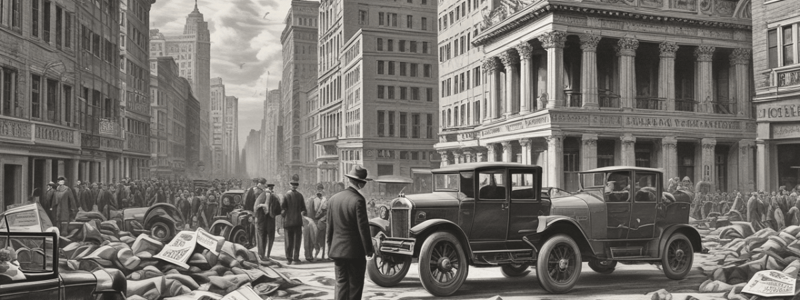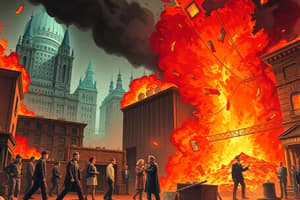Podcast
Questions and Answers
What was the primary factor that contributed to the exponential growth of the stock market from 1921 to 1929?
What was the primary factor that contributed to the exponential growth of the stock market from 1921 to 1929?
- Investments made with borrowed money (correct)
- Government regulations on the stock market
- Increased competition among brokerage houses
- Decreased optimism in the stock market
What was the approximate percentage loss of the Dow Jones Industrial Average by November 1929?
What was the approximate percentage loss of the Dow Jones Industrial Average by November 1929?
- 75% loss of its value
- 50% loss of its value (correct)
- 90% loss of its value
- 25% loss of its value
What was the period leading up to the Stock Market Crash of 1929 known as?
What was the period leading up to the Stock Market Crash of 1929 known as?
- The Economic Boom
- The Great Depression
- The Roaring Twenties (correct)
- The Post-War Era
What was the result of the Stock Market Crash of 1929?
What was the result of the Stock Market Crash of 1929?
Why did individuals and corporations borrow money to invest in the stock market?
Why did individuals and corporations borrow money to invest in the stock market?
What was the date of the stock market crash?
What was the date of the stock market crash?
What was the influence of the end of World War I on the stock market?
What was the influence of the end of World War I on the stock market?
What was the concern of the Federal Reserve in early 1929?
What was the concern of the Federal Reserve in early 1929?
What event marked the beginning of the Great Depression?
What event marked the beginning of the Great Depression?
What was the effect of the lack of capital and hesitancy of investors after the initial stock market crash?
What was the effect of the lack of capital and hesitancy of investors after the initial stock market crash?
Why did banks struggle for years after the stock market crash?
Why did banks struggle for years after the stock market crash?
What led to the saturation of the stock market in early 1929?
What led to the saturation of the stock market in early 1929?
How did people purchase stocks in the 1920s?
How did people purchase stocks in the 1920s?
What was the result of the failure of banks and the stock market?
What was the result of the failure of banks and the stock market?
How much money did banks collectively lose by 1933?
How much money did banks collectively lose by 1933?
Flashcards are hidden until you start studying
Study Notes
The Great Depression
- The Federal Reserve raised concerns about speculation in the stock market in early 1929, warning that too much money was invested in profiting from stocks rather than supporting the goods those stocks represented.
- The stock market crash of 1929 occurred in late October, marking the beginning of the Great Depression.
- The crash was triggered by over-confidence in the stock market, leading to extreme distrust of the market.
- The economy suffered for years due to the initial crash and later lack of capital and hesitancy on the part of investors.
Wall Street Crash and Its Aftermath
- Banks struggled for years after the crash because they were responsible for loans issued to speculators before the crash.
- Many banks had invested their own holdings in the stock market and lost their clients' savings.
- When it became clear that banks could not insure their depositors' money, panic ensued, shaking Americans' faith in banks and the stock market.
The Roaring Twenties
- The 1920s were a time of great prosperity for many, especially large corporations, due to the development of new technology and refined industrial methods.
- The decade became known for its progressive social changes and economic growth, with businessmen and their companies amassing unheard of wealth.
- Much of this newfound wealth was invested in the stock market, leading many to believe that the market could not fail.
Market Saturation
- The stock market was saturated in early 1929, with a small market slide in the spring of that year indicating that boundless confidence in Wall Street was likely unfounded.
- Investment merely stagnated, rather than crashing, indicating that the market simply could not support further investment.
Consumer Credit
- Consumer credit was a key factor that led to market saturation and the eventual banking crisis.
- People borrowed money to invest in the stock market, which meant stocks were purchased with loans instead of cash.
Failure of Leadership
- American leaders of the 1920s contributed to the Wall Street Crash of 1929 by allowing unfettered growth and investment without adequate study of the market.
- President Herbert Hoover grossly underestimated the seriousness of the crash, along with many other political leaders.
- Banks were allowed to engage in market speculation with their clients' money, without a formal separation between banks and markets.
The Great Depression Summary
- The stock market crash and subsequent banking crisis created a feedback loop that allowed the economic downturn to last for years.
- By 1933, many of the banks throughout the U.S. had failed, having collectively lost more than $100 million of their depositors' money.
Stock Market Crash of 1929
- The Wall Street Crash of 1929 was precipitated by financial excess and rapid corporate growth throughout the 1920s.
- The stock market had grown at an exponential rate from 1921 to the summer of 1929, largely as a result of borrowed money being invested in the stock market.
- The autumn of 1929 saw the stock market plateau briefly, then crash on October 29, 1929.
- By November of 1929, the Dow Jones Industrial Average had lost roughly half of its value from the summer of that year.
Studying That Suits You
Use AI to generate personalized quizzes and flashcards to suit your learning preferences.




